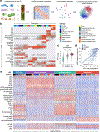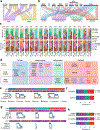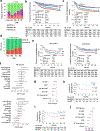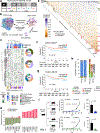Clinical and Biological Subtypes of B-cell Lymphoma Revealed by Microenvironmental Signatures
- PMID: 33541860
- PMCID: PMC8178179
- DOI: 10.1158/2159-8290.CD-20-0839
Clinical and Biological Subtypes of B-cell Lymphoma Revealed by Microenvironmental Signatures
Abstract
Diffuse large B-cell lymphoma (DLBCL) is a biologically and clinically heterogeneous disease. Transcriptomic and genetic characterization of DLBCL has increased the understanding of its intrinsic pathogenesis and provided potential therapeutic targets. However, the role of the microenvironment in DLBCL biology remains less understood. Here, we performed a transcriptomic analysis of the microenvironment of 4,655 DLBCLs from multiple independent cohorts and described four major lymphoma microenvironment categories that associate with distinct biological aberrations and clinical behavior. We also found evidence of genetic and epigenetic mechanisms deployed by cancer cells to evade microenvironmental constraints of lymphoma growth, supporting the rationale for implementing DNA hypomethylating agents in selected patients with DLBCL. In addition, our work uncovered new therapeutic vulnerabilities in the biochemical composition of the extracellular matrix that were exploited to decrease DLBCL proliferation in preclinical models. This novel classification provides a road map for the biological characterization and therapeutic exploitation of the DLBCL microenvironment. SIGNIFICANCE: In a translational relevant transcriptomic-based classification, we characterized the microenvironment as a critical component of the B-cell lymphoma biology and associated it with the DLBCL clinical behavior establishing a novel opportunity for targeting therapies.This article is highlighted in the In This Issue feature, p. 1307.
©2021 American Association for Cancer Research.
Conflict of interest statement
Conflict of interest:
J.P.L. served as a consultant for Sutro, Miltenyi, AstraZeneca, Epizyme, Roche/Genentech, BMS/Celgene, Regeneron, ADC Therapeutics, MEI Pharma, Bayer and Gilead/Kite. N.K., A.B., Z.A., V.S., E.T., N.K., N.M., F.F., M.T., N.A. and N.F. hold shares in BostonGene. A.M.M. received research funding from Sanofi and Janssen, served as consultant for Epizyme, Constellation and Jubiland, and served as scientific advisor for KDAC. L.C. received research funding from BMS/Celgene. All other authors declare no competing interests.
Figures







References
Publication types
MeSH terms
Grants and funding
LinkOut - more resources
Full Text Sources
Other Literature Sources
Medical
Molecular Biology Databases

